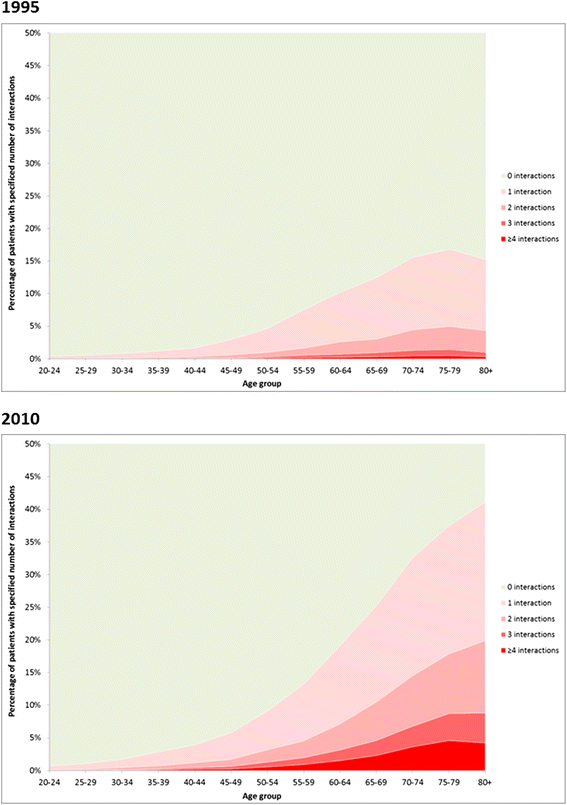The rising tide of polypharmacy and drug-drug interactions: population database analysis 1995-2010
- PMID: 25889849
- PMCID: PMC4417329
- DOI: 10.1186/s12916-015-0322-7
The rising tide of polypharmacy and drug-drug interactions: population database analysis 1995-2010
Abstract
Background: The escalating use of prescribed drugs has increasingly raised concerns about polypharmacy. This study aims to examine changes in rates of polypharmacy and potentially serious drug-drug interactions in a stable geographical population between 1995 and 2010.
Methods: This is a repeated cross-sectional analysis of community-dispensed prescribing data for all 310,000 adults resident in the Tayside region of Scotland in 1995 and 2010. The number of drug classes dispensed and the number of potentially serious drug-drug interactions (DDIs) in the previous 84 days were calculated, and age-sex standardised rates in 1995 and 2010 compared. Patient characteristics associated with receipt of ≥ 10 drugs and with the presence of one or more DDIs were examined using multilevel logistic regression to account for clustering of patients within primary care practices.
Results: Between 1995 and 2010, the proportion of adults dispensed ≥ 5 drugs doubled to 20.8%, and the proportion dispensed ≥ 10 tripled to 5.8%. Receipt of ≥ 10 drugs was strongly associated with increasing age (20-29 years, 0.3%; ≥ 80 years, 24.0%; adjusted OR, 118.3; 95% CI, 99.5-140.7) but was also independently more common in people living in more deprived areas (adjusted OR most vs. least deprived quintile, 2.36; 95% CI, 2.22-2.51), and in people resident in a care home (adjusted OR, 2.88; 95% CI, 2.65-3.13). The proportion with potentially serious drug-drug interactions more than doubled to 13% of adults in 2010, and the number of drugs dispensed was the characteristic most strongly associated with this (10.9% if dispensed 2-4 drugs vs. 80.8% if dispensed ≥ 15 drugs; adjusted OR, 26.8; 95% CI 24.5-29.3).
Conclusions: Drug regimens are increasingly complex and potentially harmful, and people with polypharmacy need regular review and prescribing optimisation. Research is needed to better understand the impact of multiple interacting drugs as used in real-world practice and to evaluate the effect of medicine optimisation interventions on quality of life and mortality.
Figures
References
-
- Burgess C, Holman C, Satti A. Adverse drug reactions in older Australians, 1981–2002. Med J Aust. 2005;182:267–70. - PubMed
Publication types
MeSH terms
Grants and funding
LinkOut - more resources
Full Text Sources
Other Literature Sources
Medical



